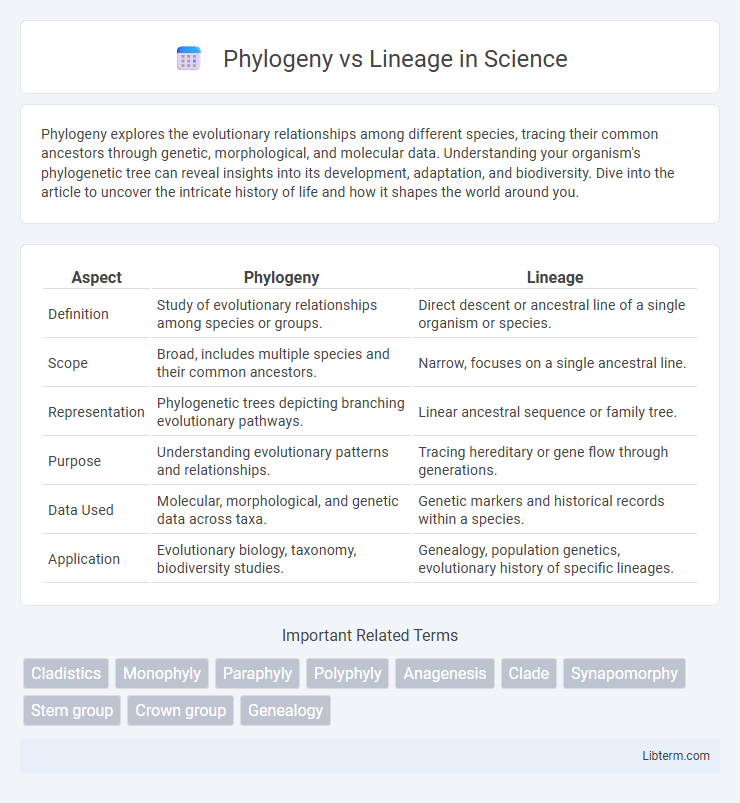Phylogeny explores the evolutionary relationships among different species, tracing their common ancestors through genetic, morphological, and molecular data. Understanding your organism's phylogenetic tree can reveal insights into its development, adaptation, and biodiversity. Dive into the article to uncover the intricate history of life and how it shapes the world around you.
Table of Comparison
| Aspect | Phylogeny | Lineage |
|---|---|---|
| Definition | Study of evolutionary relationships among species or groups. | Direct descent or ancestral line of a single organism or species. |
| Scope | Broad, includes multiple species and their common ancestors. | Narrow, focuses on a single ancestral line. |
| Representation | Phylogenetic trees depicting branching evolutionary pathways. | Linear ancestral sequence or family tree. |
| Purpose | Understanding evolutionary patterns and relationships. | Tracing hereditary or gene flow through generations. |
| Data Used | Molecular, morphological, and genetic data across taxa. | Genetic markers and historical records within a species. |
| Application | Evolutionary biology, taxonomy, biodiversity studies. | Genealogy, population genetics, evolutionary history of specific lineages. |
Introduction to Phylogeny and Lineage
Phylogeny refers to the evolutionary history and relationships among species, often represented through phylogenetic trees that illustrate shared ancestry and divergence. Lineage denotes a direct sequence of ancestors and descendants, emphasizing genetic continuity within a specific group over time. Understanding phylogeny provides a broader framework for evolutionary connections, while lineage tracks the genetic inheritance along a singular ancestral path.
Defining Phylogeny: Evolutionary Relationships
Phylogeny represents the evolutionary relationships among species or groups, depicted through a branching tree-like diagram called a phylogenetic tree. This tree illustrates common ancestors and divergence over time, showing how species are related through descent. Phylogeny emphasizes the historical patterns of shared ancestry rather than just direct hereditary lines found in lineage.
Understanding Lineage: Ancestral Paths
Lineage traces the direct ancestral paths of organisms, highlighting the sequence of descent from common ancestors through successive generations. It emphasizes the inherited genetic relationships within a species or population, providing a clear framework for studying evolutionary history at the individual or family level. Understanding lineage enables precise mapping of inherited traits and gene flow across generations, distinguishing it from broader phylogenetic trees that compare multiple species.
Key Differences Between Phylogeny and Lineage
Phylogeny represents the evolutionary relationships among species or groups, often depicted as a branching tree showing ancestral connections based on genetic, morphological, or molecular data. Lineage refers to a direct sequence of ancestors and descendants, highlighting a specific ancestral line over time within a species or group. The key difference lies in phylogeny's broad depiction of evolutionary history across multiple taxa, while lineage focuses on the direct descent path through generations.
The Role of Phylogenetic Trees
Phylogenetic trees visually represent evolutionary relationships by mapping lineage divergence based on genetic, morphological, or molecular data. They reveal common ancestors, track evolutionary paths, and clarify how distinct species or lineages are related over time. These trees inform taxonomy, comparative biology, and evolutionary studies by providing a structured framework to interpret lineage history and species evolution.
Importance of Lineage in Evolutionary Biology
Lineage traces the direct ancestral-descendant relationships within species, providing crucial insights into evolutionary processes and genetic inheritance patterns. It enables researchers to reconstruct evolutionary history, identify shared traits, and understand species diversification over time. Emphasizing lineage helps clarify the continuity of life forms and the mechanisms driving evolutionary change, complementing broader phylogenetic analyses.
Tools and Methods for Analyzing Phylogeny
Phylogenetic analysis employs tools such as maximum likelihood, Bayesian inference, and neighbor-joining to reconstruct evolutionary relationships based on genetic data. Software platforms like MEGA, BEAST, and RAxML facilitate sequence alignment, model selection, and tree visualization, enabling accurate interpretation of evolutionary history. Molecular markers, including mitochondrial DNA and ribosomal RNA sequences, serve as critical data for inferring phylogeny over lineage tracing, which often relies on pedigree or historical records.
Real-world Examples: Phylogeny vs Lineage
Phylogeny traces the evolutionary relationships among species, exemplified by the phylogenetic tree of Darwin's finches illustrating adaptive radiation in the Galapagos Islands. Lineage follows the direct descent of a single ancestral line, such as the human Y-chromosome lineage used to track paternal ancestry in populations. While phylogeny maps broad evolutionary patterns among species, lineage zooms in on the genetic or ancestral continuity within a specific family or group.
Implications in Genetics and Biodiversity
Phylogeny reveals evolutionary relationships among species by constructing trees based on genetic data, aiding in identifying common ancestors and genetic divergence crucial for biodiversity conservation. Lineage traces direct descent through ancestral genes, providing insights into hereditary traits and population genetics that inform breeding programs and genetic disorder studies. Understanding both concepts enhances genetic mapping accuracy and promotes strategies to maintain ecosystem resilience and species diversity.
Conclusion: Integrating Phylogeny and Lineage
Integrating phylogeny and lineage enhances the understanding of evolutionary relationships and individual genetic histories by combining broad species-level analysis with precise ancestral pathways. Phylogenetic trees provide macroevolutionary context, while lineage tracing reveals microevolutionary dynamics within populations. This synthesis improves accuracy in evolutionary biology, guiding research in genetics, taxonomy, and conservation biology.
Phylogeny Infographic

 libterm.com
libterm.com